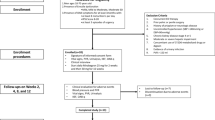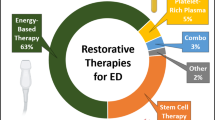Abstract
Defining the minimal clinically meaningful improvement (MCMI) is crucial to understanding the treatment effects on health-status measures. We estimated the MCMI on the quality of erection questionnaire (QEQ), a validated measure specific to assess erectile quality during sexual intercourse. Data were from two controlled trials of an investigational phosphodiesterase type 5 inhibitor. Improvement on the Erectile Function domain of the International Index of Erectile Function was used as the anchor. For men who improved by exactly 1 erectile dysfunction severity category (anchor group (n=95)), clinically meaningful improvement (CMI, estimated with mean QEQ total change score from baseline to end of treatment) and MCMI (estimated with the lower limit of the 95% confidence interval of the mean) were 22.4 (s.d., 2.2) and 18.0 points, respectively. For the difference between the anchor group and men with no change in severity category (n=116), CMI and MCMI were 17.7 (s.d., 2.9) and 12 points, respectively. Distribution-based analyses (baseline s.e. of measurement (s.e.m.)=7.99, end-of-treatment s.e.m.=8.22 and s.e. of difference=11.46) supported a proposed MCMI of 12 points. Convergence of anchor-based and distribution-based criteria supports at least a 12-point difference in QEQ scores between treatments as clinically important.
This is a preview of subscription content, access via your institution
Access options
Subscribe to this journal
Receive 8 print issues and online access
$259.00 per year
only $32.38 per issue
Buy this article
- Purchase on Springer Link
- Instant access to full article PDF
Prices may be subject to local taxes which are calculated during checkout

Similar content being viewed by others
References
Lowy M, Collins S, Bloch MT, Gillman M, Lording DW, Sutherland P et al. Quality of Erection Questionnaire correlates: change in erection quality with erectile function, hardness, and psychosocial measures in men treated with sildenafil for erectile dysfunction. J Sex Med 2007; 4: 83–92.
Porst H, Gilbert C, Collins S, Huang X, Symonds T, Stecher V et al. Development and validation of the Quality of Erection Questionnaire. J Sex Med 2007; 4: 372–381.
Cappelleri JC, Stecher VJ . An assessment of patient-reported outcomes for men with erectile dysfunction: Pfizer's perspective. Int J Impot Res 2008; 20: 343–357.
Kadioglu A, Grohmann W, Depko A, Levinson IP, Sun F, Collins S et al. Quality of erections in men treated with flexible-dose sildenafil for erectile dysfunction: multicenter trial with a double-blind, randomized, placebo-controlled phase and an open-label phase. J Sex Med 2008; 5: 726–734.
Cappelleri JC, Rosen RC, Smith MD, Mishra A, Osterloh IH . Diagnostic evaluation of the erectile function domain of the International Index of Erectile Function. Urology 1999; 54: 346–351.
Rosen RC, Riley A, Wagner G, Osterloh IH, Kirkpatrick J, Mishra A . The International Index of Erectile Function (IIEF): a multidimensional scale for assessment of erectile dysfunction. Urology 1997; 49: 822–830.
Mulhall JP, Goldstein I, Bushmakin AG, Cappelleri JC, Hvidsten K . Validation of the Erection Hardness Score (EHS). J Sex Med 2007; 4: 1626–1634.
Althof SE, Corty EW, Levine SB, Levine F, Burnett AL, McVary K et al. EDITS: development of questionnaires for evaluating satisfaction with treatments for erectile dysfunction. Urology 1999; 53: 793–799.
Cappelleri JC, Althof SE, Siegel RL, Shpilsky A, Bell SS, Duttagupta S . Development and validation of the Self-Esteem And Relationship (SEAR) questionnaire in erectile dysfunction. Int J Impot Res 2004; 16: 30–38.
Zonana Farca E, Francolugo-Vélez V, Moy-Eransus C, Orozco Bravo A, Tseng LJ, Stecher VJ . Self-esteem, confidence and relationship satisfaction in men with erectile dysfunction: a randomized, parallel-group, double-blind, placebo-controlled study of sildenafil in Mexico. Int J Impot Res 2008; 20: 402–424.
Crosby RD, Kolotkin RL, Williams GR . Defining clinically meaningful change in health-related quality of life. J Clin Epidemiol 2003; 56: 395–407.
Symonds T, Berzon R, Marquis P, Rummans TA . The clinical significance of quality-of-life results: practical considerations for specific audiences. Mayo Clin Proc 2002; 77: 572–583.
US Food and Drug Administration. Guidance for Industry: Patient-Reported Outcome Measures: Use in Medical Product Development to Support Labeling Claims February 2006.
Guyatt GH, Osoba D, Wu AW, Wyrwich KW, Norman GR . Methods to explain the clinical significance of health status measures. Mayo Clin Proc 2002; 77: 371–383.
Cella D, Eton DT, Fairclough DL, Bonomi P, Heyes AE, Silberman C et al. What is a clinically meaningful change on the Functional Assessment of Cancer Therapy-Lung (FACT-L) Questionnaire? Results from Eastern Cooperative Oncology Group (ECOG) Study 5592. J Clin Epidemiol 2002; 55: 285–295.
Data on file. Pfizer, New York, NY, 2007.
Fitzpatrick R, Norquist JM, Jenkinson C . Distribution-based criteria for change in health-related quality of life in Parkinson's disease. J Clin Epidemiol 2004; 57: 40–44.
Wyrwich KW . Minimal important difference thresholds and the standard error of measurement: is there a connection? J Biopharm Stat 2004; 14: 97–110.
Wyrwich KW, Tierney WM, Wolinsky FD . Further evidence supporting an SEM-based criterion for identifying meaningful intra-individual changes in health-related quality of life. J Clin Epidemiol 1999; 52: 861–873.
Wyrwich KW, Tierney WM, Wolinsky FD . Using the standard error of measurement to identify important changes on the Asthma Quality of Life Questionnaire. Qual Life Res 2002; 11: 1–7.
Fitzpatrick R, Norquist JM, Jenkinson C . Distribution-based criteria for change in health-related quality of life in Parkinson's disease. J Clin Epidemiol 2004; 57: 40–44.
Hays RD, Farivar SS, Liu H . Approaches and recommendations for estimating minimally important differences for health-related quality of life measures. COPD 2005; 2: 63–67.
Sloan JA, Cella D, Frost M, Guyatt GH, Sprangers M, Symonds T . Assessing clinical significance in measuring oncology patient quality of life: introduction to the symposium, content overview, and definition of terms. Mayo Clin Proc 2002; 77: 367–370.
Eton DT, Cella D, Yost KJ, Yount SE, Peterman AH, Neuberg DS et al. A combination of distribution- and anchor-based approaches determined minimally important differences (MIDs) for four endpoints in a breast cancer scale. J Clin Epidemiol 2004; 57: 898–910.
Osoba D, Rodrigues G, Myles J, Zee B, Pater J . Interpreting the significance of changes in health-related quality-of-life scores. J Clin Oncol 1998; 16: 139–144.
Coyne KS, Matza LS, Thomspon CL, Kopp ZS, Khullar V . Determining the importance of change in the Overactive Bladder Questionnaire. J Urol 2006; 176: 627–632.
McLeod LD, Fehnel SE, Brandman J, Symonds T . Evaluating minimal clinically important differences for the acne-specific quality of life questionnaire. Pharmacoeconomics 2003; 21: 1069–1079.
Cappelleri JC, Althof SE, O'Leary MP, Glina S, King R, Stecher VJ et al. Clinically meaningful improvement on the self-esteem and relationship questionnaire in men with erectile dysfunction. Qual Life Res 2007; 16: 1203–1210.
Data on file. Global Better Sex Survey: Conducted by Harris Interactive, sponsored by Pfizer, New York, NY, 2006..
Claes H, Opsomer R-J, Andrianne R, Vanbelle S, Albert A, Vanderdonck F . Characteristics and expectations of patients with erectile dysfunction: results of the SCORED study. Int J Impot Res 2008; 20: 418–424.
Acknowledgements
The study was funded by Pfizer. Editorial support was provided by Deborah M Campoli-Richards, BSPHA, RPh, of Complete Healthcare Communications, and was funded by Pfizer. All authors participated in the conception and design of the study, helped to draft and revise the paper, and read and approved of the final version. Martin Carlsson performed the statistical analysis.
Author information
Authors and Affiliations
Corresponding author
Rights and permissions
About this article
Cite this article
Hvidsten, K., Carlsson, M., Stecher, V. et al. Clinically meaningful improvement on the quality of erection questionnaire in men with erectile dysfunction. Int J Impot Res 22, 45–50 (2010). https://doi.org/10.1038/ijir.2009.47
Received:
Revised:
Accepted:
Published:
Issue Date:
DOI: https://doi.org/10.1038/ijir.2009.47



